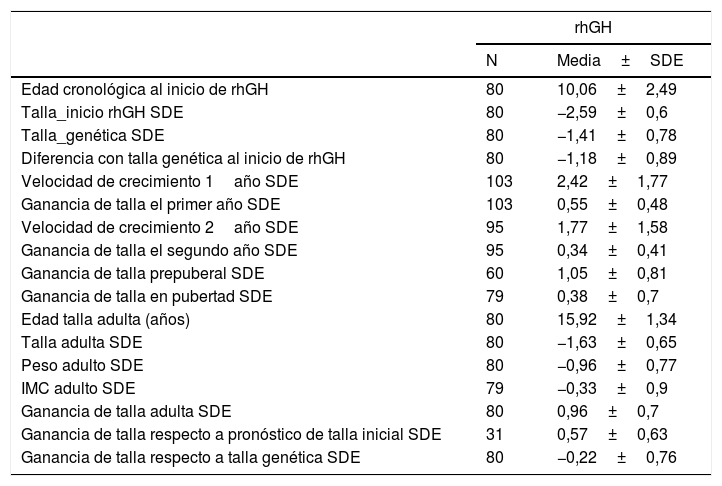El tratamiento con hormona de crecimiento recombinante humana (rhGH) en niños nacidos pequeños para la edad gestacional (PEG) se ha mostrado eficaz, aunque con variedad en la respuesta. Se evalúa la talla adulta y los factores que determinan la respuesta a largo plazo.
Pacientes y métodosEstudio retrospectivo de 80 pacientes PEG tratados con rhGH por baja talla y seguidos hasta la talla adulta (23 varones).
ResultadosEl grupo que inició el tratamiento antes de la pubertad alcanzó mayor talla adulta (−1,4±0,6 vs. −1,9±0,6 púberes). Existió mayor ganancia de talla en los tratados durante ≥ 2 años en prepubertad (1,32±0,5 SDE). Los factores asociados con una mayor ganancia de talla fueron: a) la menor talla, peso e IMC al inicio; b) la menor edad cronológica, ósea y el menor nivel de IGF-I iniciales; c) la mayor distancia con la talla genética; d) la mayor velocidad de crecimiento el primer y el segundo año y la mayor ganancia de talla previa y durante la pubertad. El porcentaje de buena respuesta en el primer año varió entre el 46,6 y el 81,6% en función del criterio empleado. El incremento de la velocidad de crecimiento≥3cm/año es el que mejor se relaciona con buena respuesta a largo plazo.
ConclusionesEl tratamiento con rhGH en niños PEG produce un incremento variable de talla adulta, que les permite alcanzar su rango genético. Los mejores resultados se producen en el grupo con mayor número de años en tratamiento en la prepubertad y no dependen de la respuesta hipofisaria de GH.
Recombinant human growth hormone (rhGH) treatment in small for gestational age (SGA) children has been effective, although there is significant variability in the response. Adult height and the factors that determine the long-term response are evaluated.
Patients and designA retrospective study of 80 patients born SGA with short stature treated with rhGH and followed until adult height (23 males).
ResultsThe group starting treatment pre-puberty reached a higher Adult height (−1.4±0.6 vs. −1.9±.6 in pubertal children), the highest final height gain was achieved in those treated for at least 2years prepuberty (1.32±.5 SDS). Factors associated with greater adult height gain were: a) less height, weight and BMI at start of treatment, b) lower chronological and bone age with lower IGF-I before treatment, c) greater distance to target height, d) higher growth velocity the first and second year of treatment, and higher height gain before and during puberty. The percentage of patients with good response in the first year ranged from 46.6% to 81.6% depending on the criteria. Growth velocity increase ≥3cm/ first year correlated best with long-term response.
ConclusionrhGH treatment in children born SGA produced a varying increase in adult height that allowed them to reach their adult height. The best results occurred in the prepubertal group and did not depend on pituitary GH response.












